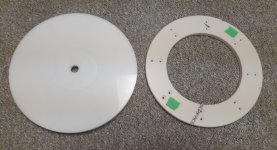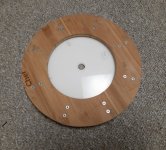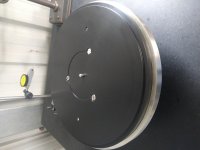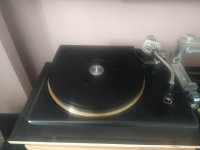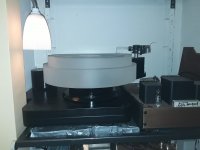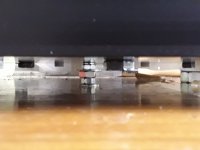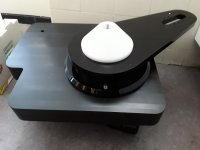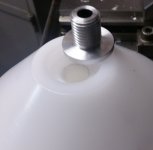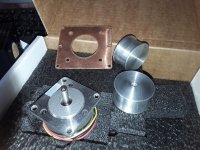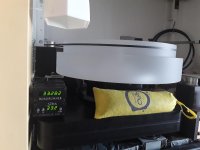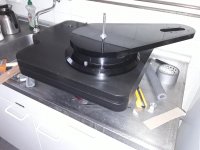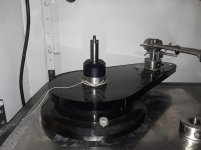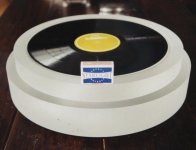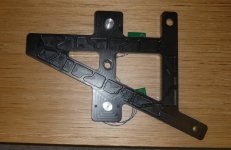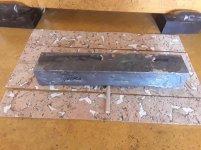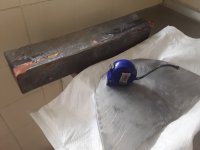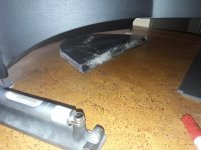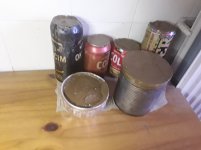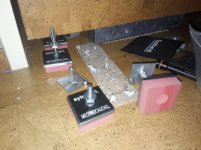POM is Polyoxymethylene which is Acetal, Delrin is Duponts proprietary product and to call POM Delrin it must meet Dupont specification.
There are glue systems that will bond POM that effectively melt it together. But regular glue is not effective as POM is designed to have very low co-efficient of friction thus making it slippery and almost impossible to glue.
There are glue systems that will bond POM that effectively melt it together. But regular glue is not effective as POM is designed to have very low co-efficient of friction thus making it slippery and almost impossible to glue.
Hi Hugh
The POM/Acetal was stacked to the SS because POM flat plate warps when machined. The SS also keeps COM low and provides inertia.
POM thickness has an impact on sound quality. I made myself 2 platters POM bonded to gunmetal, 1 has 10mm POM and the other has 20mm POM both bonded to identical gunmetal bases. The 20mm POM has far greater detail retrieval and lower noise floor than the 10mm. The 10mmPOM/GM out performs the stock platter and bare SS with OEM mat by a large margin.
Bon sent me another 20mm sheet of POM I will be bonding this to an OEM platter shortly. It will be interesting to compare this to the POM/Gunmetal and POM/SS.
On a side note I removed the damping material from the bottom of the platter I will be bonding the POM to and found that the damping material had hardened and the glue (contact cement) had failed in many spots, rendering the damping ineffective.
Warrjon, Bon,
Nice project! How thick will the Gunmetal be? How will you bond it to the POM?
Prior to ordering a Tangospinner Delrin platter, I tried some 3/8" Acetal using two different backings. Like you said, flatness is an issue.
The cream coloured ring is Corian, The biege one is bamboo. I liked the bamboo one best. I may try other backings later.
I'd love to hear how your 20mm one goes.
Thanks,
Hugh
Attachments
Hello,
I have a made a turntable '' base '' with pom.
Pom material is very difficult to glue. I never try to glue it because i knew it takes a very special glue.
My base consist of two pom CNC machined plates connected together by nylon bolts. I made some M8 or M10 threaded holes in one of the plates. I wanted to use bolts that would have similar properties like the POM anyway no metal bolts.
Greetings, Eduard.
P.s as you can see i also got the arm base and the motor base machined from POM
Hi Eduard,
Looks good. Is that lead shot I see in one photo?
Hugh
The reason POM warps is because of the grain structure in the sheet. If you use round bar it won't warp but round bar is eyewateringly expensive approx $1200/m (3ft).
So bolting POM to a stable base prevents it warping as well as lowering COM and providing more inertia.
First pic is Bon's platter this is Stainless Steel / 16mmPOM the second pic is my gunmetal / 20mmPOM.
Bon's platter will not fit a stock SP10 as it was made to his specification to fit his Kaneta SP10.
This GM / POM will fit a stock SP10mk2 chassis but I have had issues with voids in the GM so have machined my platter smaller OD (approx 315mm) to remove these voids. Mine uses 20mm POM which leaves the motor spindle below the top so a secondary spindle was made that does not touch the motor spindle.
As I said I am going to bolt 20mm POM to a stock platter and test it against the SS and GM / POM, as both Bon and I suspect the POM is doing all the heavy lifting regarding noise floor and detail retrieval.
So bolting POM to a stable base prevents it warping as well as lowering COM and providing more inertia.
First pic is Bon's platter this is Stainless Steel / 16mmPOM the second pic is my gunmetal / 20mmPOM.
Bon's platter will not fit a stock SP10 as it was made to his specification to fit his Kaneta SP10.
This GM / POM will fit a stock SP10mk2 chassis but I have had issues with voids in the GM so have machined my platter smaller OD (approx 315mm) to remove these voids. Mine uses 20mm POM which leaves the motor spindle below the top so a secondary spindle was made that does not touch the motor spindle.
As I said I am going to bolt 20mm POM to a stock platter and test it against the SS and GM / POM, as both Bon and I suspect the POM is doing all the heavy lifting regarding noise floor and detail retrieval.
Attachments
Hello,
Probably it will be beneficial to not use a metal connection between the metal and the pom because it will function as a kind of '' bridge '' for the vibrations to pass from one material to the other one. And i think the aim is to get the transfer all over the surface.
Maybe using a kind of plastic bolts or a kind of dowel ( wood or even a teflon rod ) could work. If you make it a tight fit and make a little hole in the center the teflon can be '' reshaped '' to get a good grip. You wont needed any glue.
Greetings , Eduard
Probably it will be beneficial to not use a metal connection between the metal and the pom because it will function as a kind of '' bridge '' for the vibrations to pass from one material to the other one. And i think the aim is to get the transfer all over the surface.
Maybe using a kind of plastic bolts or a kind of dowel ( wood or even a teflon rod ) could work. If you make it a tight fit and make a little hole in the center the teflon can be '' reshaped '' to get a good grip. You wont needed any glue.
Greetings , Eduard
Hello Hugh,
It is indeed lead shot and some cavities are partly filled with some foam because the actual turntable base that is attached to the two pom plates by means of 3 holes will move the center of gravity away from where you want it to be. You want it to be close to the platter bearing. This will allow me to have a very similar load on all 3 feet ( Townshend seismic load cell) because you want them to work in the same conditions. As you can see there is more pom material on the '' wall side '' of the base AND that will also be the area where motor housing and arm base are located so you need more lead shot on the '' front side ''
I have done a test to locate the exact center of gravity by balancing the complete unit on a rounded bolt and nut.
The pom motor housing has lead filled cavities with different diameter and going in different directions to get an irregular '' volume '' for the vibrations to travel through.
Normally the platter is attached by the a big bolt and an inverted bearing. With this platter this will create a big cavity in the center of the platter. SO i decided to have a special shape white pom to fill the gap leaving just a little air ( empty spaces must be avoided in turntables) Had some aluminium threaded part that is fixed onto the white pom and which will be used to mount the bearing creating some extra vibration killing.
Greetings, Eduard
It is indeed lead shot and some cavities are partly filled with some foam because the actual turntable base that is attached to the two pom plates by means of 3 holes will move the center of gravity away from where you want it to be. You want it to be close to the platter bearing. This will allow me to have a very similar load on all 3 feet ( Townshend seismic load cell) because you want them to work in the same conditions. As you can see there is more pom material on the '' wall side '' of the base AND that will also be the area where motor housing and arm base are located so you need more lead shot on the '' front side ''
I have done a test to locate the exact center of gravity by balancing the complete unit on a rounded bolt and nut.
The pom motor housing has lead filled cavities with different diameter and going in different directions to get an irregular '' volume '' for the vibrations to travel through.
Normally the platter is attached by the a big bolt and an inverted bearing. With this platter this will create a big cavity in the center of the platter. SO i decided to have a special shape white pom to fill the gap leaving just a little air ( empty spaces must be avoided in turntables) Had some aluminium threaded part that is fixed onto the white pom and which will be used to mount the bearing creating some extra vibration killing.
Greetings, Eduard
Attachments
Hi Eduard.
Is you turntable direct drive? I don't see a location for a separate motor, so I assume it is, correct?
What made you choose POM for the plinth material? The data available does not give it a high damping factor. Maybe the lead shot is the main contributor.
Is the platter also POM?
Is you turntable direct drive? I don't see a location for a separate motor, so I assume it is, correct?
What made you choose POM for the plinth material? The data available does not give it a high damping factor. Maybe the lead shot is the main contributor.
Is the platter also POM?
Hello,
It is a belt driven turntable.
The motor is kind of hidden behind the big acrylic platter which i bought from Scheu in Germany LONG time ago. The original base is black acrylic which has a big cavity filled with leadshot
The motor is a so called Sota Eclipse package. I decided to buy it without a housing because i wanted to make a pom housing.
My decision to go for pom was encouraged by some people using this material for diy turntable. If i remember well the properties are close to the vinyl used to make records.
The French also constructed some turntables combining some kind of '' plastic '' and lead.
Greetings, Eduard
It is a belt driven turntable.
The motor is kind of hidden behind the big acrylic platter which i bought from Scheu in Germany LONG time ago. The original base is black acrylic which has a big cavity filled with leadshot
The motor is a so called Sota Eclipse package. I decided to buy it without a housing because i wanted to make a pom housing.
My decision to go for pom was encouraged by some people using this material for diy turntable. If i remember well the properties are close to the vinyl used to make records.
The French also constructed some turntables combining some kind of '' plastic '' and lead.
Greetings, Eduard
Attachments
Hello,
Thanks. This has been a very time consuming project because i kind of collected ideas and parts almost worldwide. .
The white pom was made by a retired engineer with a nice " mancave "
The black pom at a high tech supplier of all kind of plastic products close to my house.
The pulleys also a company close by.
The platter, original base and bearing Scheu in Germany.
Motor unit plus speed control. Sota in the USA.
Belt Origin live in the UK.
Feet Townshend seismic cell UK
Lead ( for molding) and lead shot local company.
Greetings,Eduard
Thanks. This has been a very time consuming project because i kind of collected ideas and parts almost worldwide. .
The white pom was made by a retired engineer with a nice " mancave "
The black pom at a high tech supplier of all kind of plastic products close to my house.
The pulleys also a company close by.
The platter, original base and bearing Scheu in Germany.
Motor unit plus speed control. Sota in the USA.
Belt Origin live in the UK.
Feet Townshend seismic cell UK
Lead ( for molding) and lead shot local company.
Greetings,Eduard
POM is Polyoxymethylene which is Acetal, Delrin is Duponts proprietary product and to call POM Delrin it must meet Dupont specification.
There are glue systems that will bond POM that effectively melt it together. But regular glue is not effective as POM is designed to have very low co-efficient of friction thus making it slippery and almost impossible to glue.
Hi warrjon,
As you seem to know something of Delrin's properties ... I'd be grateful for your advice.
Attached is a pic of the TT chassis that I recently had CNC'd out of Delrin. (This was to replace a previous chassis that I had constructed from bolted-together pieces of aluminium C-section.)
My problem is that the weight of the bearing housing and Linn inner & outer platters - located in the circular rebate between the two motor pulleys - is causing the hypotenuse of the triangle to bow. (Given the ends of the hypotenuse are supported by Linn springs.)
So I need to stiffen the hypotenuse. I was thinking of doing this by fixing a length of aluminium right-angle (say, 20x10x3mm) to the underside of the hypotenuse - my question is ... is there a glue I can buy to do this?
Or will I need to bolt the aluminium angle to the Delrin?
If you have any input for my dilemma ... that would be great.
Andy
Attachments
Hello Andy,
I have worked with pom before and i never even tried to glue it. IF i would some parts to be glued i would surely ask the company where i got my parts machined for help. If you are building your own furniture there is a huge collection of glue that can be used and that will function for decades. If you wanna make a nice wooden boat your choices are restricted. For your turntable ask a professional.
At my old company we assembled a product that needed some glue. Sometimes the customer took 100 products and after one year there was one part in one product that didnt stay foot. Especially these one purpose glues come with an exact instruction HOW to use it and you can not do it with one line from an instruction from another glue. It might stick in the beginning but could fall apart during transport, temperature change.
What i surely wouldnt do is using an aluminium L or T shape to make your CNC machined part more rigid. I think if you use a T with the horizontal part about the same '' surface '' as the the hypotenuse and the vertical part just 1/2 inch high it will be perfect ( for me!). You could have it machined from Delrin but also from a material close to the properties of Delrin but offering just another type of reaction to vibration. If i remember well the French in the past used materials in this way to allow vibrations to pass from one material into the other to make the vibrations go down.
Bolting them together would allow some material to be used between the two parts . BUT this could introduce some bowing/movement if to flexible. It could well be that a nice piece of lead with a regular thickness ( usually the one from the shop will be good) will allow the added T to add rigidity ( because there will be no voids on either side of the lead) and add some extra vibration killing properties.
As you can see i just added some extra lead to my speakers.
I have worked with pom before and i never even tried to glue it. IF i would some parts to be glued i would surely ask the company where i got my parts machined for help. If you are building your own furniture there is a huge collection of glue that can be used and that will function for decades. If you wanna make a nice wooden boat your choices are restricted. For your turntable ask a professional.
At my old company we assembled a product that needed some glue. Sometimes the customer took 100 products and after one year there was one part in one product that didnt stay foot. Especially these one purpose glues come with an exact instruction HOW to use it and you can not do it with one line from an instruction from another glue. It might stick in the beginning but could fall apart during transport, temperature change.
What i surely wouldnt do is using an aluminium L or T shape to make your CNC machined part more rigid. I think if you use a T with the horizontal part about the same '' surface '' as the the hypotenuse and the vertical part just 1/2 inch high it will be perfect ( for me!). You could have it machined from Delrin but also from a material close to the properties of Delrin but offering just another type of reaction to vibration. If i remember well the French in the past used materials in this way to allow vibrations to pass from one material into the other to make the vibrations go down.
Bolting them together would allow some material to be used between the two parts . BUT this could introduce some bowing/movement if to flexible. It could well be that a nice piece of lead with a regular thickness ( usually the one from the shop will be good) will allow the added T to add rigidity ( because there will be no voids on either side of the lead) and add some extra vibration killing properties.
As you can see i just added some extra lead to my speakers.
Attachments
I'll add some of my experiences in setting up a SP10 MKII to this Thread.
As for investigating using differing effects of Materials as a Inter Related Assembly at interface of the TT's:
Platter>Platter Mat Vinyl>Vinyl LP >Spindle Clamp/Weight>Cartridge,
I have quite a few hours experience that will maybe offer a additional direction.
Firstly, I have my own dedicated music room, that leaves me to produce a aesthetic that would be rejected in many shared space environments.
My usage of Materials is quite robust and honest in the transparency of how the Materials are configured in a assembly.
Any method I am using can be produced in a aesthetic that could become a acceptable focal point, it would just need a Dimension Trim of a Material and a cosmetic coating of some type to allow for the integration into a space to be in keeping with a decor scheme.
Secondly, TT's are reactive in a environment and the chances of Two Differing Locations offering the same environment, in relation to how energies are met and distributed are very slim.
Thirdly, There are simple methods to achieve a replay from Vinyl that will satisfy many end users.
For a 'proportion of end users', the Interface of the TT in the available environment, and mechanical interfaces within the assembly of the TT's materials, can become a focal point that becomes on par to the importance
for sharing in the enjoyment of listening to a Vinyl LP.
I have evolved over time into a member of the 'proportion of end users' who delve into the 'What If's' and become investigative.
I have used various TT Supports/Racks from a Spiked Stand to Wall Mounted Shelf.
Today I use a Isolation Base seated on the Floor, the base is made of three different materials, stacked in three tiers, all capable of receiving a Point Loading.
The Base has a Wooden Frame Rack mounted on it using a Highly Compressive Strength Rubber/ Foam Footer.
The Rack is not Jointed with traditional wood Joints, but has the joints secured with 10mm Allen Head Bolt Fastenings.
This Mechanical Joint allows for a specific amount of tension to be applied at a joint, along with the option to insert a isolator into the Joint between the Two Different wood materials used for the Vertical Supports and Horizontal Braces.
A damping pad used as a insert washer, that can be selected up to 3mm in depth has been utilised.
The list of materials have been available for use (Felt, Rubber, Plastic or Cork Material Washer) to be inserted into the Joint, before tension is applied.
Additionally the Rack is strapped with a 30mm Width ratchet cargo straps to apply different tensions on the Framing.
I am a believer that Sub Plinth arrangements are as important as Plinth Material Choices for a TT.
The Top Shelve (Granite) belonging to the Rack, is mounted on a Cork Pad Isolation, and has a assembly of materials and devices placed upon it to produce a Sub Plinth assembly for the TT.
A Home Built Air Suspension Device, using a Plywood Box built from a material that has a additional layers per inch, and a increased compression during fabrication, to the usual production of a Birch Plywood.
The assembly of the Box allows for it to operate like like a Air Suspension.
This is Sub-Sub Plinth, and is seated on the Granite Shelve using the earlier referred to Rubber/Foam Footer.
This is levelled using using weights when the additional Tiers are placed on it.
The Top of this Sub Sub Plinth has a AT-616 Supports placed on it, to be used as the Footers for the Sub Plinth.
I have through various trials arrived at a place where I lean toward Compressed Materials to be used as a Sub Plinth Material.
To date I have found Chip Board can be very useful, and using different compressions of the material will show changes that can be audibly detected.
I still use Chip Board today as one of the Tiers of material used for a Sub Plinth under a Speaker.
Today my choice of Sub Plinth Material under a TT, is a Highly Compressed Foam, that has a appearance of a MDF Board, and has a structure that offers
Mechanical Properties.
A inquisitiveness about using this material developed, and when A/B trialling it, this material had produced a attenuation that was just right for my personal preferences.
Foams today are a regular got to for my attenuation preferences.
The Top of this Sub Plinth has an additional footer used, that has superseded my use of the AT 616 as a TT Plinth Footer.
The Footer is a Solid Tech 'feet of silence', the introduction of these feet into my environment where the TT is set up was quite something.
A lot happened that was unexpected, and only for the betterment of the set up.
These experiences of noticeable changes of improvements are quite personal,
and it might be very restricted to the environment used in, so it is hard to
make recommendations.
The Support System as set up above is a selection of materialsA/B trialled to experience their values to how the TT's replay is being perceived by the end user.
The Support System from the Granite Shelve Upwards, is quite easy to work with when investigations are restricted to the Racks Top Shelve and TT Sub Plinth Assemblies.
Any thing lower than the Racks Top Shelve has a much more time consuming approach needed for further investigations, unless a Tensioning of the Fastenings or Cargo Strap is to be carried out.
I feel I have this assembly at a point where if works to my preferences,
any any additional changes will in my assessment be more of slight change in the Flavour Offered other than a improvement.
Getting Back on Topic with this thread.
I am using the Science and Experiences Undertaken of others when it has come to my new direction used on a TT's Plinth Material.
I have changed my approach from Mass Materials (9 Stone Granite Plinth on a Idler Drive) to manage imparted energies, to Materials that can Dissipate and Damp imparted energies.
I have a nice piece of Slate set aside for a Mass Plinth, to be used on a SP10 MK II, but at present am happy to learn a bit about the use of a Modern Composite Materials as a Plinth, as this material choice is working quite well, when used as combination with the Mass Loaded Shelve belonging tot the Rack.
I have a immediate access to Densified Woods such as MU 25 (in use) and
Permali (upcoming project).
Permali being similar in properties to Panzerholz and from previous investigations have learned that Polybentonite Resin is a similar product to Densified Wood when Damping properties are being measured.
The 'in use' MU25 Plinth is mounted on the 'feet of silence' footers.
I have tried a variety of Isolation Pads between the footers Top Ball and Plinths underside, but can't detect any changes to be seen as worthwhile.
There is a curiosity about how a change of the 'feet of silence' ball diameter and material used will effect the sound, but this is one for the future, when other final choices are discovered.
All of my Tweaks and alterations are always assessed using a selection of Platter Mats, as these are items that are quite obvious and noticeable in how they can effect the Presentation, I have acquired a selection of Materials to be used during the assessments,
i.e, Tenuto Gunmetal, Gun Metal Platter ( to be machined to become a Platter able to suit a few TT's as a Platter), AT-600 Ceramic, Compressed Foam in
3mm and 5mm Depths (Differences between thicknesses are able to be Audible Detected), Sony Gel Filled Rubber, Rubber, and Cork.
In my listening environment, there are three 'Go To Materials' that are all acceptable to my preferences, but will show a delivery that has a range that is being perceived as 'slightly lean' in comparison to one that is capable of appearing to have a little more 'meat on the bone'.
All are capable of producing a delivery where the notes appear to be delivered with similarities in Airiness, Ambience, Crispness, Decay.
I don't lean towards any perception of the beginnings of a Bloated / Congested Delivery and other Mats in the line up of mats available, can easily create the perception that a unwanted delivery is beginning to manifest when compared as a A/B.
My three 'Go To Materials' are the Tenuto (Lean), Ceramic(slight addition of weight) and 5mm Foam (additional weight is most noticeable compared to Gunmetal)
With the above experiences and experiment/trials undertaken it is possible to understand how the use of different metals for a Platter and different compositions of Materials can produce a Platter that offers a perception of improvement over another material.
The additional testing methods to try and put a Match between the Data becoming available and the Audible Perceptions are beyond my own experiences undertaken.
In relation to the use of Acetal POM as a Material.
My experiences with this type of material is mainly through Delrin.
Delrin is available with different densities and lubricant impregnation, it is found in environments where Metal to Metal contact are avoided and when used for this purpose, the design is for the Delrin to be a sacrificial material to exchanged with ease, as and when required.
I do not know if Acetal POM and Delrin are the same in relation to additives used to produce the desired properties for the Material.
Additionally there are very similar products that are with added varying quantities of graphite as additives, which is used to lessen the coefficients of friction for the material.
Maybe these different additives and the quantities used,
will account for the variation to the Data produced for Two Products that have similar base materials, and are assumed to be close relatives in their measured Damping Properties.
This Thread 'fanned the flame' for my interest in this type of investigation, and has led me to consult with another experienced engineer and TT minded friend, as well as a fellow SP 10 MK II owner on this very subject.
There may be a few additional and useful experiences to be reported on in the coming months.
As for investigating using differing effects of Materials as a Inter Related Assembly at interface of the TT's:
Platter>Platter Mat Vinyl>Vinyl LP >Spindle Clamp/Weight>Cartridge,
I have quite a few hours experience that will maybe offer a additional direction.
Firstly, I have my own dedicated music room, that leaves me to produce a aesthetic that would be rejected in many shared space environments.
My usage of Materials is quite robust and honest in the transparency of how the Materials are configured in a assembly.
Any method I am using can be produced in a aesthetic that could become a acceptable focal point, it would just need a Dimension Trim of a Material and a cosmetic coating of some type to allow for the integration into a space to be in keeping with a decor scheme.
Secondly, TT's are reactive in a environment and the chances of Two Differing Locations offering the same environment, in relation to how energies are met and distributed are very slim.
Thirdly, There are simple methods to achieve a replay from Vinyl that will satisfy many end users.
For a 'proportion of end users', the Interface of the TT in the available environment, and mechanical interfaces within the assembly of the TT's materials, can become a focal point that becomes on par to the importance
for sharing in the enjoyment of listening to a Vinyl LP.
I have evolved over time into a member of the 'proportion of end users' who delve into the 'What If's' and become investigative.
I have used various TT Supports/Racks from a Spiked Stand to Wall Mounted Shelf.
Today I use a Isolation Base seated on the Floor, the base is made of three different materials, stacked in three tiers, all capable of receiving a Point Loading.
The Base has a Wooden Frame Rack mounted on it using a Highly Compressive Strength Rubber/ Foam Footer.
The Rack is not Jointed with traditional wood Joints, but has the joints secured with 10mm Allen Head Bolt Fastenings.
This Mechanical Joint allows for a specific amount of tension to be applied at a joint, along with the option to insert a isolator into the Joint between the Two Different wood materials used for the Vertical Supports and Horizontal Braces.
A damping pad used as a insert washer, that can be selected up to 3mm in depth has been utilised.
The list of materials have been available for use (Felt, Rubber, Plastic or Cork Material Washer) to be inserted into the Joint, before tension is applied.
Additionally the Rack is strapped with a 30mm Width ratchet cargo straps to apply different tensions on the Framing.
I am a believer that Sub Plinth arrangements are as important as Plinth Material Choices for a TT.
The Top Shelve (Granite) belonging to the Rack, is mounted on a Cork Pad Isolation, and has a assembly of materials and devices placed upon it to produce a Sub Plinth assembly for the TT.
A Home Built Air Suspension Device, using a Plywood Box built from a material that has a additional layers per inch, and a increased compression during fabrication, to the usual production of a Birch Plywood.
The assembly of the Box allows for it to operate like like a Air Suspension.
This is Sub-Sub Plinth, and is seated on the Granite Shelve using the earlier referred to Rubber/Foam Footer.
This is levelled using using weights when the additional Tiers are placed on it.
The Top of this Sub Sub Plinth has a AT-616 Supports placed on it, to be used as the Footers for the Sub Plinth.
I have through various trials arrived at a place where I lean toward Compressed Materials to be used as a Sub Plinth Material.
To date I have found Chip Board can be very useful, and using different compressions of the material will show changes that can be audibly detected.
I still use Chip Board today as one of the Tiers of material used for a Sub Plinth under a Speaker.
Today my choice of Sub Plinth Material under a TT, is a Highly Compressed Foam, that has a appearance of a MDF Board, and has a structure that offers
Mechanical Properties.
A inquisitiveness about using this material developed, and when A/B trialling it, this material had produced a attenuation that was just right for my personal preferences.
Foams today are a regular got to for my attenuation preferences.
The Top of this Sub Plinth has an additional footer used, that has superseded my use of the AT 616 as a TT Plinth Footer.
The Footer is a Solid Tech 'feet of silence', the introduction of these feet into my environment where the TT is set up was quite something.
A lot happened that was unexpected, and only for the betterment of the set up.
These experiences of noticeable changes of improvements are quite personal,
and it might be very restricted to the environment used in, so it is hard to
make recommendations.
The Support System as set up above is a selection of materialsA/B trialled to experience their values to how the TT's replay is being perceived by the end user.
The Support System from the Granite Shelve Upwards, is quite easy to work with when investigations are restricted to the Racks Top Shelve and TT Sub Plinth Assemblies.
Any thing lower than the Racks Top Shelve has a much more time consuming approach needed for further investigations, unless a Tensioning of the Fastenings or Cargo Strap is to be carried out.
I feel I have this assembly at a point where if works to my preferences,
any any additional changes will in my assessment be more of slight change in the Flavour Offered other than a improvement.
Getting Back on Topic with this thread.
I am using the Science and Experiences Undertaken of others when it has come to my new direction used on a TT's Plinth Material.
I have changed my approach from Mass Materials (9 Stone Granite Plinth on a Idler Drive) to manage imparted energies, to Materials that can Dissipate and Damp imparted energies.
I have a nice piece of Slate set aside for a Mass Plinth, to be used on a SP10 MK II, but at present am happy to learn a bit about the use of a Modern Composite Materials as a Plinth, as this material choice is working quite well, when used as combination with the Mass Loaded Shelve belonging tot the Rack.
I have a immediate access to Densified Woods such as MU 25 (in use) and
Permali (upcoming project).
Permali being similar in properties to Panzerholz and from previous investigations have learned that Polybentonite Resin is a similar product to Densified Wood when Damping properties are being measured.
The 'in use' MU25 Plinth is mounted on the 'feet of silence' footers.
I have tried a variety of Isolation Pads between the footers Top Ball and Plinths underside, but can't detect any changes to be seen as worthwhile.
There is a curiosity about how a change of the 'feet of silence' ball diameter and material used will effect the sound, but this is one for the future, when other final choices are discovered.
All of my Tweaks and alterations are always assessed using a selection of Platter Mats, as these are items that are quite obvious and noticeable in how they can effect the Presentation, I have acquired a selection of Materials to be used during the assessments,
i.e, Tenuto Gunmetal, Gun Metal Platter ( to be machined to become a Platter able to suit a few TT's as a Platter), AT-600 Ceramic, Compressed Foam in
3mm and 5mm Depths (Differences between thicknesses are able to be Audible Detected), Sony Gel Filled Rubber, Rubber, and Cork.
In my listening environment, there are three 'Go To Materials' that are all acceptable to my preferences, but will show a delivery that has a range that is being perceived as 'slightly lean' in comparison to one that is capable of appearing to have a little more 'meat on the bone'.
All are capable of producing a delivery where the notes appear to be delivered with similarities in Airiness, Ambience, Crispness, Decay.
I don't lean towards any perception of the beginnings of a Bloated / Congested Delivery and other Mats in the line up of mats available, can easily create the perception that a unwanted delivery is beginning to manifest when compared as a A/B.
My three 'Go To Materials' are the Tenuto (Lean), Ceramic(slight addition of weight) and 5mm Foam (additional weight is most noticeable compared to Gunmetal)
With the above experiences and experiment/trials undertaken it is possible to understand how the use of different metals for a Platter and different compositions of Materials can produce a Platter that offers a perception of improvement over another material.
The additional testing methods to try and put a Match between the Data becoming available and the Audible Perceptions are beyond my own experiences undertaken.
In relation to the use of Acetal POM as a Material.
My experiences with this type of material is mainly through Delrin.
Delrin is available with different densities and lubricant impregnation, it is found in environments where Metal to Metal contact are avoided and when used for this purpose, the design is for the Delrin to be a sacrificial material to exchanged with ease, as and when required.
I do not know if Acetal POM and Delrin are the same in relation to additives used to produce the desired properties for the Material.
Additionally there are very similar products that are with added varying quantities of graphite as additives, which is used to lessen the coefficients of friction for the material.
Maybe these different additives and the quantities used,
will account for the variation to the Data produced for Two Products that have similar base materials, and are assumed to be close relatives in their measured Damping Properties.
This Thread 'fanned the flame' for my interest in this type of investigation, and has led me to consult with another experienced engineer and TT minded friend, as well as a fellow SP 10 MK II owner on this very subject.
There may be a few additional and useful experiences to be reported on in the coming months.
- Home
- Source & Line
- Analogue Source
- LP mat/platter interface
